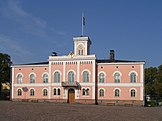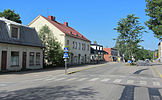Uusimaa
Uusimaa Uudenmaan maakunta landskapet Nyland | |||
|---|---|---|---|
Region | |||
| |||
| Anthem: Uusmaalaisten laulu | |||
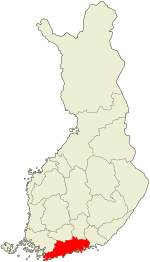 Uusimaa on a map of Finland | |||
| Country | Finland | ||
| Historical province | Uusimaa | ||
| Capital | Helsinki | ||
| Government | |||
| • Regional Mayor | Ossi Savolainen | ||
| • President of the Council | Eero Heinäluoma | ||
| Area | |||
| • Total | 9,567.99 km2 (3,694.22 sq mi) | ||
| Population (31.12.2016) | |||
| • Total | 1,638,469 | ||
| • Density | 180.1/km2 (466/sq mi) | ||
| Demonym(s) | uusmaalainen (Finnish) nylänning (Swedish) | ||
| Time zone | UTC+2 (EET) | ||
| • Summer (DST) | UTC+3 (EEST) | ||
| ISO 3166 code | FI-18 | ||
| NUTS | 181 | ||
| - Nominal GDP(2016) | €80 billion(~US$100 billion) | ||
| - Nominal GDP Per capita(2016) | €50,000(~US$60,000)[2] | ||
| Regional bird | Blackbird | ||
| Regional fish | Zander | ||
| Regional flower | Windflower | ||
| Regional animal | European hedgehog | ||
| Regional stone | Hornblende | ||
| Website | uudenmaanliitto.fi | ||
Uusimaa (Finnish: [ˈuːsimɑː]; Swedish: Nyland [²nyːland]; both lit. "new land") is a region of Finland. It borders the regions of Southwest Finland (Varsinais-Suomi), Tavastia Proper (Kanta-Häme), Päijänne Tavastia (Päijät-Häme), and Kymenlaakso. Finland’s capital and largest city, Helsinki, along with the surrounding Greater Helsinki area, are both contained in the region, which makes Uusimaa Finland's most populous region. The population of Uusimaa is 1,638,469.
Contents
1 History
2 Languages
3 Regional council
4 Municipalities
5 Gallery
6 Media
6.1 Newspapers
6.2 Radio stations
7 Heraldry
8 See also
9 References
10 External links
History
In ancient times, coastal Uusimaa was populated by Sami people. The place name of Nuuksio derives from Sami word njukča which means Swan.[3] Later Finns proper and Tavastians inhabited the area. Some place names have traces of Tavastian village names, like Konala which likely derives from older Tavastian village name Konhola.[4]Estonians inhabited the region to a smaller extent, specifically for seasonal fishing.[5]
Swedish colonisation of coastal Uusimaa started after the second crusade to Finland in the 13th century.[6][7] The colonisation was part of converting pagan areas to Catholicism. Eastern Uusimaa had its first Christian Swedish colonialists earlier than the western part, which got its colonialists in one mass transfer of people to Porvoo in the 14th century. The colonisation was supported by the Swedish kingdom and the immigrants were provided with grain seeds and cattle. They also got a four-year tax exemption from the crown.[5] All the Swedish placenames of Uusimaa date back to this period.[8]
The names Uusimaa and Nyland meaning “new land” in English derives from the Swedish colonisation era. The Swedish-language name Nyland appears in the documents from the 14th century. The Finnish-language name Uusimaa appears for the first time in 1548 as Wsimaa in the first translation of the New Testament to Finnish by Mikael Agricola.[9]
The Finnish provinces were ceded to Imperial Russia in the War of Finland in 1809. After this, Uusimaa became the Province of Uusimaa of the old lääni system. From 1997 to 2010, Uusimaa was a part of the Province of Southern Finland. It has been divided in the regions of Uusimaa and Eastern Uusimaa. In 2011, the two regions were merged.[citation needed]
Languages
Uusimaa is a bilingual region, with municipalities both bilingual in Finnish and Swedish, and monolingual in Finnish. Uusimaa's coastal areas tend to be Swedish-speaking. The traditional regional dialects of Swedish (nyländska) are currently[when?] mostly spoken in Eastern Uusimaa, while in the rest of the Uusimaa Swedish dialect has become more standardised.
The Finnish-speaking population started to grow when the capital of the Grand Duchy of Finland was moved from Turku to Helsinki by Emperor of Russia Alexander I in 1812, and the region attracted settlers from other parts of Finland. Helsinki's slang first evolved in the late 19th century. 8,5% of population of the region speak the Swedish language natively.[citation needed]
Regional council
The regional council is the main governing body for region and focuses primarily on urban planning. Like all regional councils, it is mandated by law.
Municipalities

The region of Uusimaa is made up of 26 municipalities, of which 13 have city status (marked in bold).[10]
Helsinki Sub-region:
| Raseborg Sub-region:
Loviisa Sub-region:
Porvoo Sub-region:
|
Gallery
Helsinki Cathedral, a symbol of the capital

Porvoo Old Town

Nurmijärvi Church

Ekenäs Old Town
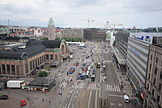
A view of central Helsinki with the Railway Station
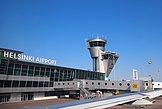
Helsinki-Vantaa Airport in Vantaa, the largest airport in Finland

A view of Hanko, the southernmost town in Finland
The cottage where Aleksis Kivi died, Tuusula; an example of late 19th century housing in the area

Fagervik Manor, Ingå; there are plenty of manor houses in the area
The medieval, late 15th century Lohja Church is one of the biggest of its kind in Finland
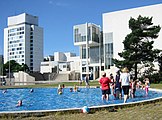
Tapiola, Espoo

Hvitträsk, a residence in national romantic style in Kirkkonummi, now a museum

A view from Fiskars, Pohja; the corporation was founded as an ironworks in the village
A rural 19th century peasant interior in Lohilampi Museum, Sammatti
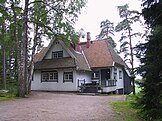
Ainola, Home of Jean Sibelius, in Järvenpää
Loviisa Town Hall

A view of Finnish Gulf in Porvoo Archipelago with Söderskär Lighthouse
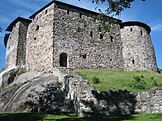
Raseborg Castle from the 14th century, partly ruined

Church of St. Lawrence in Vantaa, the oldest building in the capital region
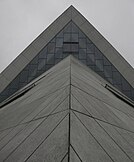
Hyvinkää Church, an example of modern Finnish church architecture
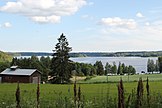
A rural landscape in Pusula with Lake Hiidenvesi

Kerava town centre tower blocks

Hirvihaara Manor, Mäntsälä
Karkkila, a small town in north of the region

Suomenlinna Fortress with the city of Helsinki in the background
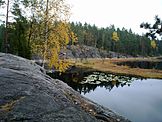
A view from Nuuksio National Park, Espoo
Leppävaara, one of Espoo's centres
Media

Hufvudstadsbladet's building, Mannerheimintie, Helsinki
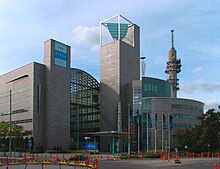
Yle's headquarters, Pasila, Helsinki
Newspapers
The largest subscription newspapers published in the region are Helsingin Sanomat and Hufvudstadsbladet in Helsinki, Aamuposti in Hyvinkää, Länsi-Uusimaa in Lohja, Loviisan Sanomat and Östra Nyland in Loviisa, Uusimaa and Borgåbladet in Porvoo, Västra Nyland in Raseborg, and Keski-Uusimaa in Tuusula. Also two popular tabloid newspapers, Iltalehti and Ilta-Sanomat, are published there.
Radio stations
Yle's local radio stations in the western part of the region are Finnish-language Ylen läntinen and Swedish-language Yle Vega Västnyland, in the Capital Region Finnish-language Yle Radio Suomi Helsinki and Swedish-language Yle Vega Huvudstadsregionen, and in the eastern part Finnish-language Yle Radio Itä-Uusimaa and Swedish-language Yle Vega Östnyland.
Heraldry
Household pennant of Finnish-speaking Uusimaa
Household pennant of Swedish-speaking Uusimaa
The coat of arms of the region shows a yellow boat which is a symbol for the coastal areas, and two silver streams which are the symbol for rivers.
Uusimaa received its coat of arms at the end of the 16th century. There is an image of the coat of arms made in 1599. In 1997, the traditional coat of arms became the official coat of arms of the region.
See also
- List of European regions by GDP
References
^ "2014 GDP per capita in 276 EU regions" (in German). Eurostat. 2014. Retrieved 3 November 2016..mw-parser-output cite.citation{font-style:inherit}.mw-parser-output .citation q{quotes:"""""""'""'"}.mw-parser-output .citation .cs1-lock-free a{background:url("//upload.wikimedia.org/wikipedia/commons/thumb/6/65/Lock-green.svg/9px-Lock-green.svg.png")no-repeat;background-position:right .1em center}.mw-parser-output .citation .cs1-lock-limited a,.mw-parser-output .citation .cs1-lock-registration a{background:url("//upload.wikimedia.org/wikipedia/commons/thumb/d/d6/Lock-gray-alt-2.svg/9px-Lock-gray-alt-2.svg.png")no-repeat;background-position:right .1em center}.mw-parser-output .citation .cs1-lock-subscription a{background:url("//upload.wikimedia.org/wikipedia/commons/thumb/a/aa/Lock-red-alt-2.svg/9px-Lock-red-alt-2.svg.png")no-repeat;background-position:right .1em center}.mw-parser-output .cs1-subscription,.mw-parser-output .cs1-registration{color:#555}.mw-parser-output .cs1-subscription span,.mw-parser-output .cs1-registration span{border-bottom:1px dotted;cursor:help}.mw-parser-output .cs1-ws-icon a{background:url("//upload.wikimedia.org/wikipedia/commons/thumb/4/4c/Wikisource-logo.svg/12px-Wikisource-logo.svg.png")no-repeat;background-position:right .1em center}.mw-parser-output code.cs1-code{color:inherit;background:inherit;border:inherit;padding:inherit}.mw-parser-output .cs1-hidden-error{display:none;font-size:100%}.mw-parser-output .cs1-visible-error{font-size:100%}.mw-parser-output .cs1-maint{display:none;color:#33aa33;margin-left:0.3em}.mw-parser-output .cs1-subscription,.mw-parser-output .cs1-registration,.mw-parser-output .cs1-format{font-size:95%}.mw-parser-output .cs1-kern-left,.mw-parser-output .cs1-kern-wl-left{padding-left:0.2em}.mw-parser-output .cs1-kern-right,.mw-parser-output .cs1-kern-wl-right{padding-right:0.2em}
^ "2014 GDP per capita in 276 EU regions" (in German). Eurostat. 2014. Retrieved 3 November 2016.
^ Tarkiainen, Kari (2010). Ruotsin itämaa. Helsinki: Svenska litteratursällskapet i Finland. p. 120.
^ Terhi Ainiala, Minna Saarelma ja Paula Sjöblom (2008). Nimistötutkimuksen perusteet. Helsinki: Suomalaisen kirjallisuuden seura. p. 66.
^ ab Tarkiainen, Kari (2010). Ruotsin itämaa. Helsinki: Svenska litteratursällskapet i Finland. pp. 119–136.
^ V.-P. Suhonen and Janne Heinonen (2011). "Helsingin keskiaikaiset ja uuden ajan alun kylänpaikat 2011, Inventointiraportti 2011. Museovirasto" (PDF).
^ Tarkiainen, Kari (2010). Ruotsin itämaa. Porvoo: Svenska litteratussällskapet i Finland. pp. 122–125. ISBN 9789515832122.
^ Terhi Ainiala, Minna Saarelma ja Paula Sjöblom (2008). Nimistötutkimuksen perusteet. Helsinki: Suomalaisen kirjallisuuden seura. p. 68.
^ Uusimaa Regional Council (May 12, 2010). "Nytt Land, Nylands historia" (in Swedish). Archived from the original on July 16, 2011. Retrieved May 17, 2010.
^ "Regional Council - Uudenmaan liitto". www.uudenmaanliitto.fi. 2013-03-05. Retrieved 2017-01-31.
External links
| Wikimedia Commons has media related to Uusimaa. |
- Uusimaa Regional Council
| Wikivoyage has a travel guide for Uusimaa. |
Coordinates: 60°15′N 24°30′E / 60.250°N 24.500°E / 60.250; 24.500

















